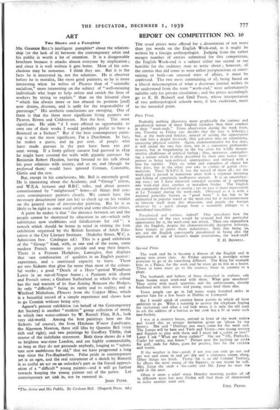ART
Two Shows and a Pamphlet
MR. GRAHAM BELL'S intelligent pamphlet* about the relation- ship (or the lack of it) between the contemporary artist and
his public is worth a lot of attention. It is a disagreeable brochure because it attacks almost everyone by implication ; and since it is well written it gets home. Most of his con- clusions may be nonsense. I think they are. But it is the facts he is interested in, not the solutions. He is observer before he is moralist, like most good painters; so he is more interesting when he writes of Picasso than of " scientific socialism," more interesting on the subject of "well-meaning individuals who hope to help artists and enrich the lives of workers by trying to explain " than on the leisured class " which has always more or less abused its position [and] now denies, disowns, and is unfit for the responsibility of patronage." His aesthetic conclusions are sweeping. One of them is that the three most significant living painters are Picasso, Rivera and Coldstream. Not the best. The most significant. He adds " if I were offered an opportunity to own one of their works I would probably prefer to have a Bonnard or a Sicken." But if the best contemporary paint- ing is not the most significant, I'm a Dutchman. In fact, he makes a guess, and 99 per cent. of people who have made guesses in the past have been too per cent. wrong. If a lively gallery curator had guessed in 1839 he might have covered the walls with gigantic canvases by Benjamin Robert Haydon, having listened to his talk about his poor relations with society, and so on, and (though he preferred them) would have ignored Cotman, Constable, Girtin and the rest.
But, except in his conclusions, Mr. Bell is extremely good.
He is interesting about the Academy, and " Group " artists, and W.E.A. lectures and B.B.C. talks, and about posters commissioned by " enlightened " firms—all things that con- cern contemporary painters closely. We cannot have the necessary detachment (nor can he) to check up on his verdict on the general state of present-day painting. But he is as likely to be right as some vocal artists and some ebullient critics.
A point he makes is that " the distance between art and the
people cannot be shortened by education in art—which only substitutes new snobbisms and falsifications for old ": a remark which should be borne in mind in visiting the loan exhibition organised by the British Institute of Adult Edu- cation at the City Literary Institute. (Stukeley Street, W.C. 2. Admission free. Catalogue id.) This is a good exhibition of the " Group " kind, with, at one end of the room, some modern French masters to preside and wag their fingers. There is a Frances Hodgkins, Lanteglos, that displays that rare combination of qualities in an English painter : experience, and a continued capacity to learn. There are two Sickerts that glow far more than most of the colour- ful works ; a good " Death of a Hero "-period Wyndham Lewis in an out-of-Vogue frame ; a Pasmore with charm and French sense; a Graham Sutherland in which the colour has the real warmth of its Sun Setting Between the Hedges, its only " difficulty " being its rarity and its reality; and a Winifred Nicholson, Flowers from the Copper Mine, which is a beautiful record of a simple experience and shows how to go Cornish without being arty.
Agnew's present exhibition (on behalf of the Contemporary
Art Society) is another " modem " group collection of merit, in which two water-colours by W. Russell Flint, R.A., look very old-world. Among the best paintings here are the Sickerts (of course), the Ivon Hitchens Winter Landscape, the Algernon Newton, three still lifes by Quentin Bell (very rich and right), and two paintings by Geoffrey Tibble, that master of the indefinite statement. Both these shows do a lot to brighten war-time London, and are highly commendable, so long as they do not persuade anybody, longing to " substi- tute new snobbisms for old," that we have progressed a long way since the Pre-Raphaelites. False pride in contemporary art is an ogre, and the real enjoyment of a sketch by Rossetti is as useful an act on an onlooker's part as the forced appreci- ation of a " difficult " young painter—and it will go further towards keeping the young painter out of the gutter. Let contemporary art sink in, not be rammed in.
JOHN PIPER.
*The Artist and His Public. By Graham Bell. (Hogarth Press. 6d.)












































 Previous page
Previous page